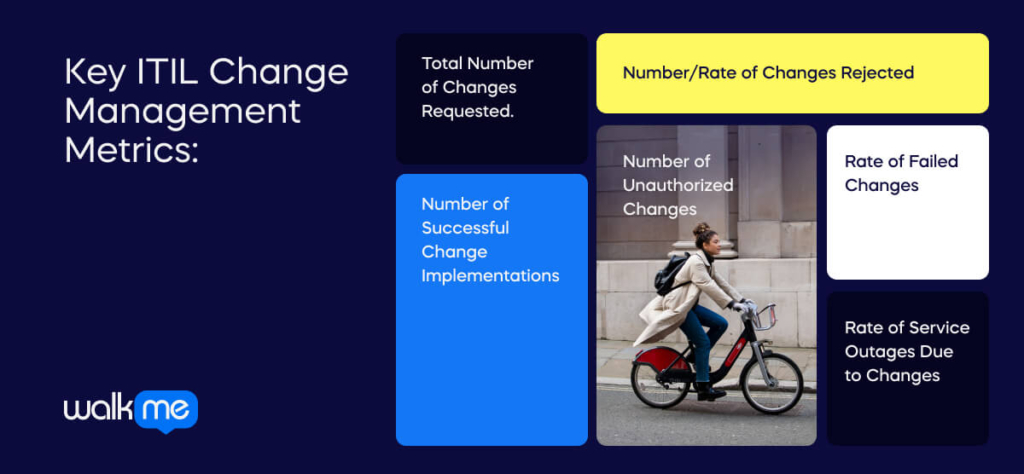Change management metrics for ITIL are different from other change management metrics.
The change models that focus on people – such as ADKAR and the Kotter model – don’t have much in common with ITIL’s change process.
This is because ITIL has a more specific scope.
So it stands to reason that ITIL change management metrics are also more specific.
ITIL vs. Change Management
ITIL change management focuses on processes, not people.
That is, ITIL belongs to IT services management (ITSM). And since ITSM focuses on IT service deliveries to customers, ITIL strictly focuses on changes to those services.
“Change management” as a whole, however, includes other types of organizational and business changes.
These can include structural, organizational, cultural, and hierarchical changes.
In ITIL, though, the main concern is about service deliveries.
What ITIL Is and Does
Because of that, its metrics also focus on improving IT service delivery.

ITIL is a streamlined pipeline – it is a process-oriented change funnel that aims to minimize business impacts, reduce risk, and optimize change processes.
Let’s quickly review what ITIL is and does:
- ITIL streamlines the change process for customer-facing IT services
- It does this by standardizing procedures for requesting, reviewing, implementing, and evaluating changes
- The ITIL change management framework provides guidelines for requests that include how requests should be submitted, handled, prioritized, and implemented
- It also provides guidelines for which parties are involved – such as requestors, Change Advisory Boards (CABs), and so on
The exact implementation of ITIL varies from company to company.
But ITIL best practices provide businesses with a usable, useful framework for IT services change management.
Change management metrics for ITIL will naturally focus on measuring performance, reducing errors, and improving processes.
20 ITIL Change Management Metrics
In ITIL’s case, optimizing the process of change management is a main concern.
Another is adherence to procedures – after all, in any large organization, deviations from standardized procedures do occur.
One purpose of establishing metrics is to spot deviations and minimize them.
Let’s look at a few ITIL metrics now:

- Total Number of Changes Requested. The total number of change requests during a given timeframe.
- Number / Rate of Changes Rejected. The number (or rate, as a percentage) of change requests that were rejected during a given time frame.
- Number of Unauthorized Changes. The total amount of changes that were implemented without authorization.
- Number of Successful Change Implementations. The number of changes that were requested, approved, and implemented successfully.
- Rate of Failed Changes. The number of changes that were requested, approved, but failed to be implemented.
- Rate of Service Outages Due to Changes. The number of service interruptions that occurred as a result from change implementations.
- Number of Changes Backlogged. The number of changes in a backlog at a given time, which can be averaged and measured against different time periods.
- Average Time to Implementation. How long changes take, on average, to complete.
- Number / Rate of Urgent Change Requests. Measurements of the number (or rate, as a percentage) of urgent change requests, versus the total number of change requests.
- Number / Rate of Major Change Requests. The number (or percentage) of major change requests, versus the total number of change requests.
- Number / Rate of Emergency Changes. The number of emergency changes versus the total number of changes.
- Number of Change-Related Incidents. The number of incidents that were related to ITSM changes.
- Number of CAB Meetings. The number of meetings by the Change Advisory Board.
- Average Time to Approval / Rejection. How long, on average, changes take to be approved or rejected.
- Change Acceptance Rate. The percentage of changes that are accepted.
- Overdue Change Rate. The amount of changes, as a rate or a number, that are overdue.
- Number / Rate of Changes Initiated by Customers. The number or percentage of changes that are initiated by customers, rather than from within the IT department or the business.
- Ratio of Change-Related Incidents to Total Number of Incidents. The number of incidents caused by ITSM changes versus the total number of incidents.
- Number / Percentage of Incidents Related to Deficient Documentation. The number or rate of incidents caused by poor documentation.
- Ratio of Changes Performed During Business Hours to Total Number of Changes. Ratio of changes performed within service windows, versus without.
These metrics are 20 of the most helpful ITIL change management metrics.
Naturally, a given company may create others, or they may wish to focus on certain types of metrics.
Final Thoughts
ITIL is a framework for change designed to optimize IT service delivery, mitigate risks, and minimize service problems.
These metrics will help any IT services department deliver better IT services and make the most of their ITIL change management process.
Bear in mind that ITIL is a set of guidelines – not a prescriptive framework.
Each company should implement ITIL in its own way and choose metrics based on its own situation.
These 20 metrics offer a great place to start.

